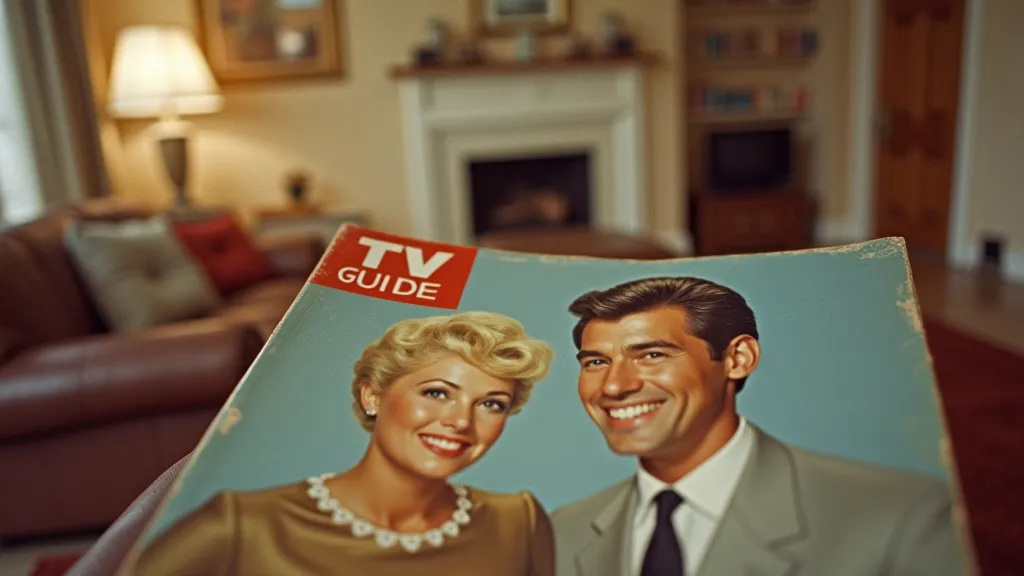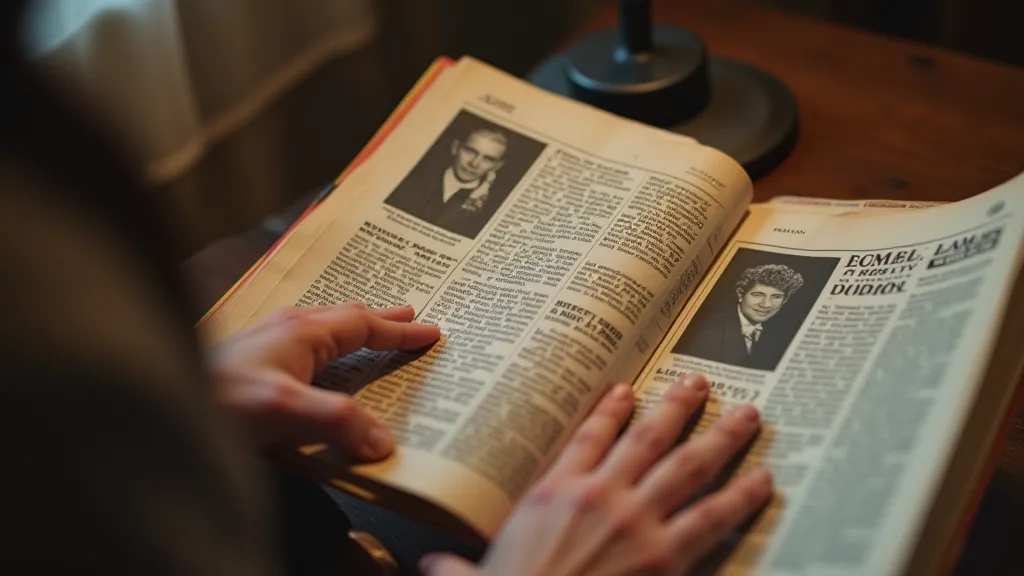The Paper Prophets: Predicting Audience Trends Through Historic TV Guide Subscription Data
There's a certain scent, isn't there? A papery, slightly musty fragrance that clings to old magazines. For those of us who collect vintage TV Guides, it's more than a smell; it's a portal. A whiff of 1962 transports you to a family gathered around a black and white console, eager for the week’s offerings. Each dog-eared page, each faded advertisement, whispers stories of a different era. But these weren’t just entertainment catalogs. They were, in their own way, barometers of American culture, and the data embedded in their subscription history offers an astonishing glimpse into how we watched, what we watched, and why.
My own fascination began with my grandfather, a quiet man who kept a meticulously organized stack of TV Guides dating back to the 1950s. He never spoke much about them, but I’m certain they represented a comforting ritual, a link to a simpler time. As a child, I’d leaf through them, marveling at the grainy photographs of Lucille Ball, Perry Mason, and the early pioneers of television. I didn’t understand the significance then, beyond the novelty of seeing how things *looked*. Now, I understand that these weren't just glossy rectangles; they were reflecting – and often shaping – the national conversation.

The Rise of the Paper Prophet
The first TV Guide debuted in 1953, quickly becoming an essential companion for the burgeoning television audience. Its success wasn't accidental. Prior to its arrival, television listings were often fragmented and unreliable, buried within local newspapers or rarely updated. TV Guide offered a national, unified listing, along with insightful program descriptions and entertaining features. Its subscription model was crucial to its success. Initially, subscriptions were priced affordably, often subsidized by advertising revenue, making them accessible to a wide range of households. Early subscription figures soared – a testament to the desperate need for readily available programming information.
Analyzing these historical subscription data reveals fascinating trends. The initial boom years (1953-1960) coincided with the golden age of television – a period of unprecedented growth and innovation. Families were rushing to acquire televisions, and TV Guide became an indispensable part of the experience. Subscription rates correlated directly with television set ownership; as more homes got TVs, more households signed up for the magazine. Geographically, subscription density initially clustered in urban and suburban areas – centers of early television adoption. The rise of local broadcast affiliates and their programming influenced regional subscription patterns. A city heavily reliant on NBC programming would have a higher TV Guide subscription rate if that magazine prioritized NBC listings.
Regional Preferences and Program Powerhouses
Delving deeper, we can see how regional preferences shaped viewing habits and, consequently, TV Guide subscription rates. The popularity of certain programs wasn’t uniformly distributed across the nation. For instance, "Gunsmoke," while a national favorite, resonated particularly strongly in the Midwest and Southwest. Areas with a strong Western heritage embraced the show wholeheartedly. Conversely, programs with a more urban or East Coast focus, like "The Jackie Gleason Show," found their largest audiences in those regions, boosting TV Guide subscriptions in those locales. These granular patterns are a testament to the power of localized content and the early seeds of targeted media consumption. It’s intriguing to consider how the format and content of these shows became so inextricably linked to regional identity, a connection that helped solidify both the shows’ popularity and the demand for a reliable guide like TV Guide.
The subscription data also reveals the power of "appointment television." Programs that demanded viewers be present at a specific time—live broadcasts, highly anticipated events—generated spikes in TV Guide subscriptions. The fear of missing out was a powerful motivator. Think about the early days of network specials or the live coverage of significant events. Families needed TV Guide to ensure they didn’t miss a moment. This was a time before DVRs and on-demand streaming; missing a show meant missing it entirely. The collective experience of tuning in together was a key part of the cultural landscape, and the magazine acted as the orchestrator of that shared moment.
The 1960s: A Decade of Change and Subscription Shifts
The 1960s marked a turning point. The decade saw a significant diversification of programming, increased competition between networks, and a growing awareness of audience demographics. Subscription rates leveled off and even declined in some areas. The rise of color television, while visually appealing, also created confusion. Early color broadcasts were limited and often unpredictable, leading some viewers to feel that the magazine wasn’t always a reliable guide. The color shifts and evolving advertising strategies of this era are a compelling case study in the challenges faced by media outlets adapting to change; a topic further explored in Chromatic Ghosts: The Evolution of Color and Advertising in 1960s TV Guides. The transition wasn’t seamless, and the inherent value proposition of a comprehensive guide like TV Guide was temporarily questioned.
Furthermore, the fragmentation of the audience—as viewers sought out more specialized programming—also impacted subscription numbers. The rise of counter-culture movements and more niche television offerings meant that TV Guide’s broad appeal began to erode. The magazine, designed to capture the interests of a national audience, struggled to remain relevant as tastes became increasingly personalized. Examining the stories behind the people who brought these shows to life and the challenges they faced adds a fascinating depth to the narrative; a perspective offered in Beyond the Schedules: Unveiling the Untold Stories of the People Behind the TV Guide. The sheer number of creative individuals involved, and their struggles to navigate the evolving media landscape, is truly remarkable.

Identifying Rarity and Value
For collectors, understanding TV Guide subscription history isn't just about appreciating the cultural narrative; it's also intrinsically linked to rarity and value. Early issues, particularly those from the 50s, are highly sought after. Issues featuring significant historical events or unusual promotional campaigns (like free giveaways) command premium prices. Regional editions—those specifically printed for a particular city or state—are also rarer and more valuable than the national editions. Recognizing these nuances requires a working knowledge of TV Guide printing schedules and distribution networks – information often gleaned from studying historical subscription data and archival records. Understanding the allure of these relics and the forces that drove their popularity offers a glimpse into a bygone era, where television was a communal experience and a reliable guide was an indispensable companion.
Furthermore, the condition of a TV Guide drastically impacts its value. Mint condition copies are exceedingly rare and treasured, while copies with significant wear and tear are less valuable. This is why preservation efforts—proper storage, careful handling—are so vital for collectors. A 1958 TV Guide featuring a rare promotional insert, in pristine condition, could fetch hundreds, or even thousands, of dollars. The inherent fragility of these paper artifacts and the dedication required to preserve them speaks volumes about the value placed on tangible memories and historical records.
Beyond the Listings: A Craftsmanship Appreciation
Beyond the historical data and the potential monetary value, there’s a simple, tactile appreciation to be had. Consider the craftsmanship involved in creating these magazines. The paper stock, the printing techniques, the graphic design—all reflect the aesthetic sensibilities of a different era. Each issue is a miniature artifact, a testament to the dedication of countless individuals, from the writers and editors to the printers and distributors. Examining a vintage TV Guide is like holding a piece of history in your hands—a tangible link to a time when entertainment was a shared experience, and a reliable guide was essential for navigating the ever-expanding world of television. It’s fascinating to consider how the changing landscape of media—from newspapers to radio to television—influenced the design and content of these guides. The very notion of what constituted "information" evolved alongside the technology itself.

The ephemeral nature of these publications adds to their unique appeal. While television programs themselves are often lost to time or exist only in fragmented archives, the TV Guides stand as a persistent record of what we watched, when we watched it, and how we felt about it. They’re a testament to the power of collective memory and the enduring legacy of a shared cultural experience. The very fact that these fragile paper documents have survived to offer such a detailed portrait of a bygone era speaks volumes about their importance.
The stories embedded within these “paper prophets” are far from over. As technology evolves and media consumption continues to transform, these historic TV Guides will remain invaluable resources, not only for collectors but also for anyone interested in understanding the evolution of American culture and the enduring power of television. They provide a unique window into a time when the lines between information, entertainment, and community were more closely intertwined, offering a valuable perspective on the forces that have shaped our modern media landscape. The persistent curiosity about this period and the enduring appeal of these tangible records suggest that their stories will continue to captivate and inform for generations to come, reminding us of the power of collective memory and the importance of preserving our cultural heritage.





